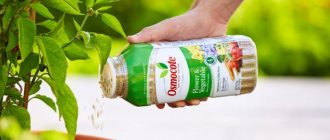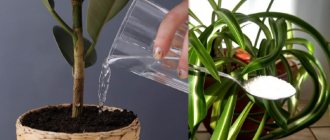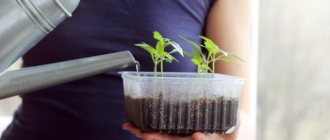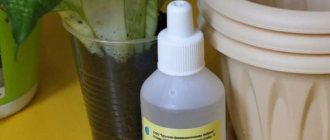Flowers are the decoration of life. This is a bright element of the interior and a wonderful gift for a woman. Many people cannot imagine life without indoor plants. Watering and feeding these lovely green spaces is a pleasant outlet after a working day or an interesting hobby. And they, in turn, thank their owners with their beauty and pleasant aroma. Even when there is a snowstorm and blizzard outside, spring can reign in your house, buds swell and fresh shoots grow.
However, caring for indoor plants is not as easy as it might seem at first glance. Some people think that you just need to water your house flowers regularly. But in pots for green spaces there is too little space, and, accordingly, there is a lack of nutrients that greens absorb from the soil. In order for indoor plants to be healthy, strong and give flowers to their owners, they need help.
It’s rare that a summer resident gets along without fertilizers on his plot, but at home they are often forgotten. But in vain. Due to the fact that bushes in pots have a limited feeding area, they must be periodically replanted in a fresh nutrient substrate and fertilized in the ground. Even if the pot is large and spacious, the plant will deplete the soil's resources over time. And after a couple of months the plant again needs feeding. Organic and mineral fertilizers can be purchased in specialized stores for impressive sums of money, or you can make them yourself, using only what you have on hand.
Some home flower lovers believe that replanting or fertilizing once every six months or even once a year is enough, but they are seriously mistaken. Minerals from the soil are depleted in just two months, after which another fertilizing is necessary. A particularly acute lack of vitamins is observed in indoor plants during rapid growth or flowering. And in a warm apartment this happens not only in the spring. With proper care, buds or buds can appear in any season.
If you see that the flowers are growing slowly, have become weak, the leaves are small, colorless, covered in spots, have begun to dry out, or simply do not want to bloom, things are bad. It is better, of course, not to bring the plants to this state, but if this does happen, you need to help your green charges and treat them with something sweet. And this is not a joke, sugar is one of the most popular fertilizers for indoor plants and other flowers. This is largely due to the fact that white fertilizers can be found in any home, in the kitchen of every good housewife. But the benefits of sugar are irrefutable and have long been confirmed by numerous studies and experiments.
The history of the use of natural and healthy sweet dishes in crop production
History is silent about who first came up with the idea of feeding flowers with sugar. What is known is that many families passed this advice down from generation to generation.
And in the twentieth century, this folk remedy received scientific justification and recognition in the most authoritative circles of biologists.
In 1907, Lyubimenko investigated the ability of the root system to absorb sugars on its own, without the influence of any microorganisms. The world-famous scientist Michurin injected sugar directly into the tissues of green experimental subjects. Other experimenters have successfully grown greenery, including ferns and algae, without any exposure to sunlight at all, simply by fertilizing it with sugar. Thus, it was proven that it is the sweet solution that can compensate for the lack of light in a certain way.
Feeding indoor flowers with sugar: a fashion statement or a necessity
At their summer cottage, almost every gardener uses fertilizers, but at home they are forgotten. Completely in vain. Bushes in pots develop in a limited area, which reduces their “diet” significantly. Periodically, they require replanting into a fresh substrate with nutrients and regular soil fertilizing.
Owners of spacious and large pots know that over time the resource reserve of the soil is depleted. After 2-2.5 months it is necessary to add a portion of micronutrients. In specialized stores you can buy mineral and organic fertilizers, taking into account the fact that their cost is quite high. You can also fertilize flowers with sugar yourself; the proportions and recipe must be followed very precisely.
Some gardeners believe that home flowers require replanting or fertilizing more often than once every 6 months, and this is their big mistake. Mineral substances leave the soil literally in 1.5-2 months, after which the addition of additional elements is required. The situation gets worse during active growth and flowering. And if we are talking about a warm apartment, then this period can occur several times during the year.
Buds and buds can form regardless of the season outside the window.
If you notice signs of slow growth, colorless and small leaves, or lack of color, then the situation requires immediate intervention. The ideal case is not to bring the plant to such a deplorable state. But if this has already happened, it is necessary to feed home flowers with sugar - one of the most popular “folk” remedies. The benefits of the crumbly white composition are irrefutable and confirmed by hundreds of studies.
The benefits of sweets
It is believed that feeding flowers with sugar is most necessary in winter, since at this time the sun is not often and the plants lack ultraviolet radiation. The same goes for greenery in dark rooms or planted in the shade. Sunlight is necessary for photosynthesis, but if it is not very active, then plants begin to use up their hidden reserves. The first thing that comes into play is sugar. This is why sweet fertilizers are so necessary in winter. Some hobbyists combine feeding home plants with sugar and installing lighting with a fluorescent lamp.
There are experiments that prove that plants that receive sugar supplements in the spring grow faster, become stronger and healthier. Such specimens bloom or sprout more often.
Sugar for orchids, violets, cacti
Orchids are popular flowers that can be found among many gardeners. Sugar water is suitable for caring for this rather whimsical flower. You can simply pour a little granulated sugar into the substrate, at the rate of 1 teaspoon per pot with a diameter of 10 cm. You can also prepare syrup.
Feeding with sugar syrup is especially good for weakened orchids. It stimulates their development and the formation of flower shoots. You can also use a sugar syrup solution to wipe the phalaenopsis leaves. It is recommended to feed the orchid with sugar in the autumn-winter period in order to support the tropical beauty during this difficult period.
They love sweet syrup and violets. Glucose solution is an excellent stimulant for abundant flowering. But you should use the product for watering violets no more than once a month.
Cacti also have a big sweet tooth. To water the prickly inhabitants of the windowsill, dilute 0.5 teaspoon of sugar in 200 g of warm water. Water once a month.
Topping up with sugar syrup is a temporary measure. The application of potassium, phosphorus, and nitrogen fertilizers cannot be canceled. Only comprehensive care when growing beautiful flowering plants and plants with beautiful lush foliage will turn them into a real decoration of the home.
Chemical laws
This effect - rapid growth, flowering and fruiting - is explained by the chemical reactions that occur. We know from school that sugar breaks down into fructose and glucose. If the first product for plants is practically useless, the tissues of green spaces are not able to absorb it and use it for their own benefit, then glucose is a vital substance.
Glucose is a universal building material from which complex organic molecules are formed - cellulose, starch, lipids, proteins and nucleic acids. On its basis, flowers grow, develop and reproduce. Moreover, glucose is the source of energy for most important plant life processes - tissue formation, respiration, nutrition, absorption of beneficial microelements from the soil, and so on.
However, in order for glucose to be well absorbed, the presence of carbon dioxide is necessary.
Therefore, experts recommend using one of the EM preparations, for example, “Baikal-EM1” when feeding plants with sugar. They contain bacteria that promote the decomposition of organic matter. This process produces carbon dioxide. This will allow you to achieve maximum suction and, accordingly, results. Otherwise, unused sugar will become food for mold or rot.
We feed the flowers... with sugar
It's no secret that indoor flowers need fertilizing, and we go to stores, buy, sometimes expensive, fertilizers and start feeding, watering and spraying the plants with them. In most cases, we get good results, but is it really necessary to spend money and use “chemicals” at home when you can use the available means.
Photo: nirutdps/ ru.depositphotos.com.
Sugar supplements support indoor flowers during the winter months when they lack light. Photo by Vitaly Pirozhkov.
Indoor roses react best to coffee grounds. Photo by Nikolai Khromov.
Photo: nirutdps/ ru.depositphotos.com.
Citrus peel feeding is especially good for spathiphyllum. Photo by Nikolai Khromov.
Watering with aquarium water is beneficial for pelargonium. Photo: vojislav/ ru.depositphotos.com.
‹
›
Few people know that ordinary yeast contributes to the growth of flowers and their full development. Yeast solution is a rich storehouse of various microelements that activate the processing of organic compounds both in the soil and in plants. In the process of their processing, the composition and quality of the soil improves, plant immunity to diseases and pests increases, and active growth and development of the root system is observed.
To prepare a growth-stimulating solution, just take 10 g (bag) of dry yeast and 4 cubes of refined sugar and dissolve in 1.5 liters of water. Keep the resulting mixture for 2 hours in a warm room, and then dilute it five times with water. For a smaller volume, 1 g of dry yeast and 1 tsp are enough. granulated sugar. When watering a flower, use 50-100 ml of solution per 1 kg of soil in a pot. It is advisable to carry out the procedure once in spring, summer and autumn.
Yeast can be used for any indoor plants, especially flowering ones. However, during fermentation, yeast can actively absorb essential elements such as potassium and calcium from the soil, sometimes in large quantities. It is quite easy to compensate for these elements: simultaneously with watering with a nutrient solution, add wood or stove ash to the pre-loosened soil - only 5-10 g, or even better, 0.5-1.0 g of potassium sulfate dissolved in soft, settled water.
It is also good to soak plant sections in a yeast solution for faster formation of the root system (12-15 days earlier).
Another effective way to feed indoor flowers is sugar. In the soil it breaks down into glucose and fructose. Plant tissues cannot absorb fructose, but glucose can become a powerful source of energy for most important processes of their life, such as respiration and absorption of nutrients. In addition, glucose is a universal building material that literally builds the most complex organic molecules. But glucose can become a builder of organic molecules if it is fully absorbed by plants, and for this a second component is needed - carbon dioxide. If there is no or little carbon dioxide in the soil, mold may appear and root rot may occur. Therefore, along with doses of sugar, it is recommended to add any of the microbiological preparations for the soil (EM preparations). These drugs contain bacteria that promote the decomposition of organic matter and the release of carbon dioxide.
The benefits of sugar have long been confirmed by numerous studies by biologists. Sugar helps support flowers in winter when they suffer from lack of light. But plants become stronger and healthier after sugar additions and in the spring. Their growth increases, flowering improves and its duration increases.
To prepare a sugar solution: 1 tbsp. l. granulated sugar is diluted in 0.6 liters of water. You can also use pure glucose - it is sold at the pharmacy: 1-2 tablets are dissolved in 1 liter of water.
It is recommended to feed with a sugar solution no more than once a month, being careful not to over-moisten the soil to prevent the formation of rot and mold.
Large plants, in particular ficus, love sugar fertilizers, but cacti also prefer them.
Coffee grounds can be a good organic food for indoor flowers. Dried coffee acts as a slow-release nitrogen fertilizer. Nitrogen is released from coffee grounds by microorganisms contained in the soil. As a result, the soil becomes looser, lighter, and more oxygen accumulates in it.
Before adding, it is advisable to dry the coffee grounds a little, and then mix them with the soil at the rate of 1 tsp. grounds per 500 g of soil. Usually this additive is enough for 5 kg of soil. You should not increase the dose, because drinking coffee in excess can acidify the soil.
Indoor roses respond best to sleeping coffee - the duration of their flowering increases and the brightness of the flowers increases. Sleeping coffee is useful for azaleas, gardenias, anthuriums, and indoor cypress. But you shouldn’t use tea leaves for fertilizing. Once in the soil, it will attract black flies - sciarids.
Valuable fertilizer for indoor flowers can be obtained from the peels of oranges, tangerines, and lemons. To prepare the infusion, cut the peel into small pieces (1 cm each), fill a third of a liter glass jar with them and pour boiling water over them for a day. After time, the infusion is filtered and topped up with settled water to the top of the jar. Apply such fertilizers once every four to five weeks, pouring 50 ml under each flower. The infusion heals both the soil and plants, increasing their immunity. In addition, the aroma of citrus fruits repels spider mites and scale insects. But if these pests have already settled on the flowers, you will have to use fungicides.
Spathiphyllum responds especially well to feeding from citrus peels.
Wood ash, which contains potassium (up to 5%) and phosphorus, is rarely used to feed indoor flowers. Stove ash is considered more useful, but wood ash also improves the composition of the soil, disinfects it, increases water and air permeability, normalizes acidity, and prevents the spread of putrefactive microflora. Potassium in the ash is necessary for the formation of buds and good flowering, and phosphorus is necessary for setting fruits and seeds.
To prepare the fertilizer, 2 tsp. The ash is dissolved in 1 liter of water and left for a week. Water with this solution once every two weeks. Top dressing is designed for 5 kg of soil. You can also use dry wood ash; it is mixed with the soil before planting or replanting plants in a ratio of 1:50.
Ash fertilizer is suitable for all indoor flowers. However, some of them are capricious and prefer acidic soils, for example, azalea, gardenia, calla lilies, anthurium, and indoor cypress. Ash can harm them by reducing the acidity of the soil.
Onion peels are also used for fertilizing; they contain many phytoncides that protect the soil from harmful insects, and when decomposed, help improve its structure. By constantly using onion peels, you can improve the quality of the soil by making it looser. Plant growth will increase and flowering will become more luxuriant.
To prepare the solution, pour a handful of onion peels (50 g) into 2 liters of water, boil for 15 minutes, let it brew for 2-3 hours, filter and spill the soil or spray flowers with it. It is advisable to do this no more than once every 45-60 days. This type of feeding is most suitable for plants planted on the balcony.
Aquarium water is considered a good natural fertilizer. It is soft, has a neutral acid-base balance and contains many microelements that stimulate the growth and development of plants. You can water flowers with this water once every 35-40 days (not more often) and it is better in spring and early summer, otherwise microscopic algae can multiply in the soil, and the earth can turn green and turn sour. Spend 1 liter of water per large flower and 0.5 liter per small flower.
Orchids react well to aquarium water; they can be watered and sprayed with this water, diluted twice. Myrtle, crossandra, and pelargonium love aquarium water.
Another rare food for indoor flowers is the water left after defrosting the meat. It contains substances that promote the formation of chlorophyll, which is necessary for all plants, in tissues. Plants should be watered with this water once every 3-4 months, after diluting them twice. No more than 100 ml of solution is poured into a flower pot with a capacity of 5-6 kg of soil. As a result, the flowers acquire a rich green color, become healthier and grow faster.
In conclusion, some general advice. Before applying any fertilizer, water the soil in the flower pot with clean water; this will help prevent the flowers from being destroyed if the fertilizer is too concentrated. Repeat watering regularly, but not year-round; flowers especially need feeding in spring and summer - during the period of active growth and flowering. Feed weakened plants very carefully, using a low concentration solution. And remember that excessive amounts of water can lead to rotting of the roots and the appearance of diseases.
Sweet cocktail
Sugar can be poured into a pot of flowers, one teaspoon at a time, then watered with clean water, or a special liquid can be made. In order to make a sweet and healthy solution, you need to take one tablespoon of sugar and dilute it in half a liter of water.
There is no consensus among scientists on how often to use this fertilizer. Some cite studies in which they applied white natural fertilizer every week and achieved excellent results. Others argue that you need to make the life of plants sweeter no more often than once every couple of months. Therefore, every lover of indoor flowers will have to solve this issue independently. The main thing is not to overdo it and prevent the formation of rot or mold.
When to apply sugar fertilizer
Sweet fertilizing can be applied 1-2 times a month, even without skipping the autumn-winter period. Since in the cold season, when there is short daylight, the plants weaken. It is important to remember that even though sugar is a universal fertilizer, you should not apply it in excess. An overdose of sugar is harmful to plants.
Take a close look at the condition of the flowers. If, after adding sweet syrup, the plants perked up and began to grow, this means that glucose is necessary and it is worth continuing to regularly add sugar syrup.
Sugar syrup can be used to water plants at the roots, but you can also irrigate the foliage. And for plants with large leaves, for example, ficus, you can wipe them with a cloth soaked in a sweet solution.
Overdose symptoms:
Sugar is an inexpensive product, so an inexperienced grower often abuses the addition of this product. You cannot pour sugar syrup into flowers. An overdose can harm the plant. Excessive application slows down growth, possibly even rotting of the roots and death of the plant.
Glucose
Pure glucose can also be used to feed indoor plants. This substance is even more effective, although it is not found in every home. It must be purchased at a pharmacy. One or two such tablets should be diluted in a liter of water, then water the resulting solution on the plant or spray its leaves.
The benefits of sugar-based fertilizers for indoor and not only indoor plants have long been proven both in theory and in practice. Now all we have to do is use the recommendations of experts. But you need to take into account that the effect for different types of plants may differ. Prickly cacti and ficus are especially fond of sweets. But even here it is important not to overdo it with fertilizing, because excessive additives can also harm the plant.
When using sugar or other fertilizers to feed indoor plants, you should pay special attention to watering. Excessive volumes of water can contribute to the leaching of nutrients from the soil. Also, because of this, the root system may begin to rot and signs of disease will appear, such as weakened stems and leaves that are yellowed or covered with strange spots. You need to know moderation in everything, and then the green creatures that live on the windowsills will give you beautiful and fragrant flowers. It is also necessary to remember about a systematic approach and regular care of plants. One spoon of sugar will undoubtedly give results, but only temporary. The procedure must be repeated regularly, as needed, and not wait for unwanted crises.
How to feed?
There are several ways to fertilize flowers.
Method number 1 . The simplest option looks like this: pour a spoonful of sugar directly into the pot, and pour water on top of the soil.
Method number 2. Sugar must be diluted in water. To prepare healthy sweet fertilizer you will need 1 tsp. sugar per half liter of settled water.
The second method is considered more effective, since glucose in liquid form reaches all the roots of the flower.
You should know that the absorption of glucose by plant tissues properly occurs only when in contact with carbon dioxide. Based on this, along with sugar feeding, it is necessary to introduce preparations based on bacteria into the soil, which promote the rapid decomposition of organic matter. For this, experienced gardeners use yeast, since their breakdown produces carbon dioxide.
Considering this rule of home flower care, you can prepare a sweet solution with the addition of yeast. For this you need 1 g of dry yeast and 1 tsp. dissolve granulated sugar in a liter of settled water. The solution consumption per 1 kg of soil is 100 ml.
It is recommended to fertilize with sugar and yeast once in the summer, autumn and spring. More frequent fertilization will not be beneficial, because yeast fungi tend to absorb from the soil useful substances necessary for the healthy development of flowers - calcium and potassium. It is advisable to introduce these microelements into the soil together with yeast in the form of wood or stove ash - only 5 - 10 g. You can also dissolve 1 g of potassium sulfate in soft, settled water.
The following rules should be followed:
- Fertilizer can be applied for the first time two months after planting in the ground.
- Before applying fertilizing, you need to water the plant well. Such actions will help protect the root system from the negative effects of the substance if it is used in high concentrations.
- Sick and weakened plants should be watered with a less concentrated solution - ½ tablespoon per liter of water.
- Fertilizer can be applied no more than once a month.
Sugar water can be used not only for watering, but also for spraying leaves. Sugar compresses are made for phalaenopsis:
- a tablespoon of granulated sugar is dissolved in a liter of water;
- moisten dry wipes in the solution and apply to the leaves;
- After half an hour, the compress is removed.
You can also wipe the leaves with a cotton swab dipped in this solution.
What are the benefits of sweet fertilizers?
Sweet fertilizer is most useful in winter, when there is an acute lack of ultraviolet rays. The situation is similar with greenery, which is kept in the shade and indoors for a long time. Without sunlight, the process of photosynthesis does not take place; plants have to consume hidden reserves. Sugar is consumed the most. In the context of which, feeding indoor flowers with sugar is required specifically in winter. Experts strongly recommend supplementing such care with fluorescent lighting.
In practice, it was possible to prove that plants grow more actively in sugar soil. They sprout more often and bloom more intensely.
Feeding flowers with sugar. Dictated by the laws of chemistry
The effect is obvious - active development of the crop, accompanied by flowering. It occurs due to chemical reactions. As sugar breaks down, glucose and fructose are formed. And if the last element is virtually useless for a living plant, the greenery is simply not able to absorb it. As for glucose, it is a vital substance.
Experts know that glucose is a universal building material in living organisms, due to which molecules on an organic basis are formed - nucleic acids, proteins, starch and cellulose. Thanks to these substances, the development and reproduction of flowers occurs. Plant life cannot function without glucose.
For the plant to absorb glucose, the presence of carbon dioxide is required.
Experienced gardeners recommend feeding plants with sugar; you can use a product called “Baikal - EM1”. It contains bacteria, thanks to which organic matter multiplies more actively. Due to this, carbon dioxide is released. Its presence determines the maximum absorption of glucose by the plant.
Daily water change
You need to change the water in the vase daily. Flowers must stand freely in the container, without ribbons or ties. The stems should be immersed in water to a height of 3-5 cm. You can add a few ice cubes. Thanks to the lower water temperature, the flowers in the vase will last as long as possible.
We bake a whole basket of “mushrooms”: we take a plastic bottle to help
“Coronavirus” benefits that will be canceled in the Russian Federation on April 1 have been named
The fate of Archil Gomiashvili’s daughter and son, who also became actors
It is also recommended to carefully trim the ends of the flowers every time you change the water. This will help the plants get the nutrients they need.











